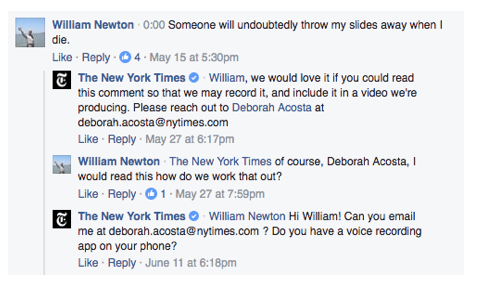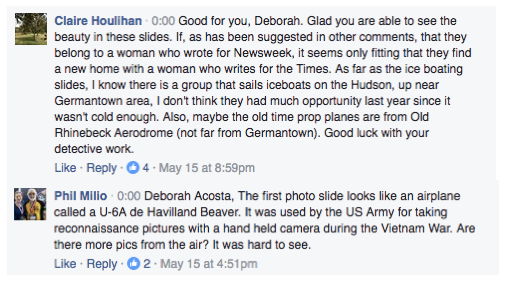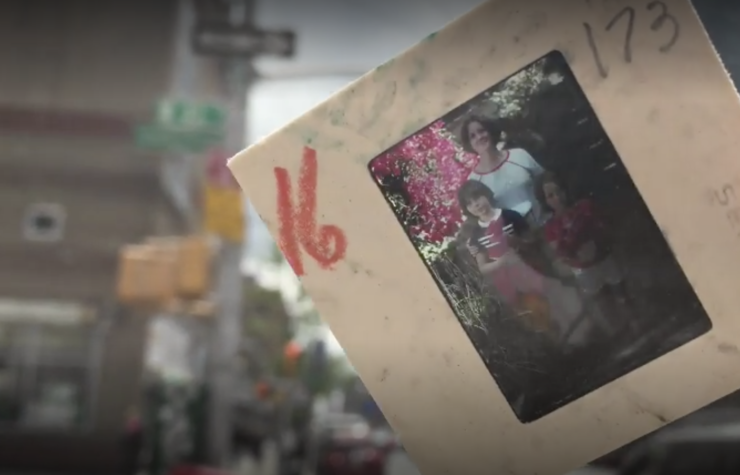One day this spring, New York Times reporter Deborah Acosta left her reporting up to serendipity.
She’d followed a trail of Kodachrome slides to a huge bag full of striking images, seemingly abandoned in a trash bin in New York City’s Hell’s Kitchen. Acosta, who had been assigned to focus on Facebook Live reporting projects, acted on intuition — she quickly sent her editor a video of herself rummaging through these lost treasures.
“When I encountered the slides that Sunday, I thought for a moment that it might be a great video project to work on in my own time, and then thought, ‘Well, maybe it would work well as a Facebook Live experiment instead,’” Acosta told me.
Her editor, Louise Story, was game. So Acosta immediately went live on the New York Times’ Facebook page (with its fairly jaw-dropping 12 million followers). In real time, she revealed the discarded contents of a life: yellowed envelopes, images of planes, frigid terrains -- and a woman.
That’s what makes “Fragments of a Life” so powerful and moving: The story is entirely about the audience’s participation in and reaction to Acosta’s discoveries.
This was a mystery, but not your typical whodunit: No one had been hurt, no one was seeking revenge, no one was trying to expose a criminal. But who would ditch such beautiful slides? And why so deliberately?

That’s what makes “Fragments of a Life” so powerful and moving: The story is entirely about the audience’s participation in and reaction to Acosta’s discoveries.
In her second live broadcast, Acosta went so far as to showcase blown-up versions of some Facebook comments from the first broadcast. She spread them across a table and called out the individual commenters (just a small handful among thousands) by name, giving voice to their hunches and embedding them in the story’s train. This tactic makes the experience feel more alive—as though viewers share ownership of its outcome.
A few other qualities made this experiment work extraordinarily well, beyond what most people have come to expect of this still-infantile medium. As one Facebook commenter wrote:

Jennifer, let me try to unpack this for you.
1. The “Unboxing” Effect
The rhythm of this series, which relies on quiet, static observation, reminds me of the Internet “unboxing” phenomenon. Much like watching someone open a package and discover what’s inside, this feels hypnotic. Acosta angles her camera toward the ground, picks up the slides one by one, and holds them to the sky. Meanwhile, she chats with her audience casually and with genuine curiosity. Most Facebook Live videos these days feature no shortage of talking heads, but Acosta’s videos make use of space, time and silence; she lets her audience ponder each slide and jot down names written on the envelopes that she digs out of the garbage bag. She doesn’t speak at times, the city noise coming into the acoustic foreground. Watching these videos is strangely therapeutic. Nothing really happens, which is something of a relief.
2. Voice Recordings
Acosta asked many of her commenters to send her recordings of themselves reading their comments. It’s similar to what WNYC’s Note to Self radio show has done with user-generated content: They routinely ask fans to send voice memos in response to a prompt, question or challenge. The intimacy of the task is what makes it so novel. When was the last time you sent a spoken “letter” to someone? In this case, Acosta wanted to translate Facebook comments into real-life speech for the project’s final video, “Fragments of a Life.” Journalism doesn’t exist in a vacuum, and interactive experiments like this show us that actual people—not just names and profile pictures—care deeply about the city and world they live in.

3. Public Empathy
A lovely thread in this series was viewers’ empathy for whoever had dumped the slides in the trash—and admiration for the journalist who fished them out. Acosta turned a seemingly mundane subject into something worthy of public examination. She tapped into her audience’s humanity to help tell the story.

4. Everyone’s an Expert
One of the main tenets of so-called citizen journalism is that everyone is an expert in something and that journalists should tap into readers’ collective intelligence rather than turn their noses up at them. By simply asking her viewers to help solve the mystery, Acosta shows how easy it is to coax audiences into providing tips and details based on life experience. Of course, any information needs to be verified. But Acosta’s project is a lesson in empowering people and entrusting them with the journalistic enterprise. Acosta told me, “I think crowdsourced reporting can help you get at deeper truths that you wouldn’t necessarily get by going at it alone.”

5. Case Closed
While following Acosta’s reporting, New York Times readers were able to complete something tangible, to fill in the pieces of an unsolved puzzle, and to find resolution in the age of the scroll. We discover that the woman in the photos is the late journalist Mariana Gosnell, and we learn why the slides were dumped there (a very poignant moment).
It’s a bit like a detective novel. Whereas a published investigative piece gives you the answers right away, an investigative story produced live (whether on Facebook or a different platform) has the narrative effect of a true detective story—as long as the reporter (the narrator) ties up enough knots. Literary critic James Schiffer wrote:
In general, the plot of detective fiction provides the gratifying reassurance of knowing that, if life is crowded with too much information and too many options, the intimate intellectual contact between the individual audience and the author/detective will unveil a single, right “interpretation,” a “thread of logic.”
Of course, in a detective novel, the actual author of the story knows what happened, and is the master of those details. But the readers are authoring what it’s like to find out, and this is exactly what Times viewers and Deborah Acosta were doing—together.



